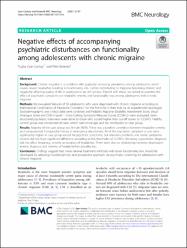| dc.contributor.author | Cankay, Tuğba Uyar | |
| dc.contributor.author | Beşenek, Mert | |
| dc.date.accessioned | 2022-07-27T07:24:09Z | |
| dc.date.available | 2022-07-27T07:24:09Z | |
| dc.date.issued | 2021 | en_US |
| dc.identifier.citation | Uyar Cankay, T., & Besenek, M. (2021). Negative effects of accompanying psychiatric disturbances on functionality among adolescents with chronic migraine. BMC neurology, 21(1), 97. https://doi.org/10.1186/s12883-021-02119-6 | en_US |
| dc.identifier.issn | 1471-2377 | |
| dc.identifier.uri | https://doi.org/10.1186/s12883-021-02119-6 | |
| dc.identifier.uri | https://hdl.handle.net/11436/6269 | |
| dc.description.abstract | Background Chronic migraine is a condition with gradually increasing prevalence among adolescents which causes severe headaches resulting in functionality loss. Factors contributing to migraine becoming chronic and negatively affecting quality of life in adolescence are still unclear. Parallel with these, we aimed to examine the effect of psychiatric symptoms on headache severity and functionality loss among adolescents with chronic migraine. Methods We evaluated features of 50 adolescents who were diagnosed with chronic migraine according to International Classification of Headache Disorders-3 for the first time in their lives by an experienced neurologist. Sociodemographic and clinical data were collected and Pediatric Migraine Disability Assessment Score, Visual Analogue Score and DSM-5 Level 1 Cross-Cutting Symptom Measure Scores (CCSM-5) were evaluated. Semi-structured psychiatric interviews were done to those who scored higher than cut-off scores on CCSM-5. Healthy control group was constituted of cases which had similar age and sex distribution to case group. Results Majority of the case group was female (%78). There was a positive correlation between headache severity and computerized tomography history in emergency department. All of the psychiatric symptom scores were significantly higher in case group except for psychotic symptoms; but attention problems and manic symptoms clusters did not have significant difference according to the thresholds of CCSM-5. Receiving a psychiatric diagnosis did not affect frequency, severity or duration of headaches. There were also no relationship between depression/anxiety diagnosis and severity of headache/functionality loss. Conclusion Findings suggest that; more rational treatment methods with lesser functionality loss should be developed by adopting multidisciplinary and prospective approach via psychiatric screening for adolescents with chronic migraine. | en_US |
| dc.language.iso | eng | en_US |
| dc.publisher | BMC | en_US |
| dc.rights | info:eu-repo/semantics/openAccess | en_US |
| dc.subject | Chronic daily headache | en_US |
| dc.subject | School-age-children | en_US |
| dc.subject | Tension type headache | en_US |
| dc.subject | Quality-of-life | en_US |
| dc.subject | K-Sads-life | en_US |
| dc.subject | Affective-disorders | en_US |
| dc.subject | Prevalence | en_US |
| dc.subject | Schizophrenia | en_US |
| dc.subject | Disability | en_US |
| dc.title | Negative effects of accompanying psychiatric disturbances on functionality among adolescents with chronic migraine | en_US |
| dc.type | article | en_US |
| dc.contributor.department | RTEÜ, Tıp Fakültesi, Dahili Tıp Bilimleri Bölümü | en_US |
| dc.contributor.institutionauthor | Cankay, Tuğba Uyar | |
| dc.contributor.institutionauthor | Beşenek, Mert | |
| dc.identifier.doi | 10.1186/s12883-021-02119-6 | en_US |
| dc.identifier.volume | 21 | en_US |
| dc.identifier.issue | 1 | en_US |
| dc.identifier.startpage | 97 | en_US |
| dc.relation.journal | BMC Neurology | en_US |
| dc.relation.publicationcategory | Makale - Uluslararası Hakemli Dergi - Kurum Öğretim Elemanı | en_US |


















